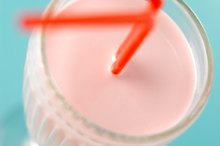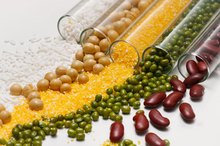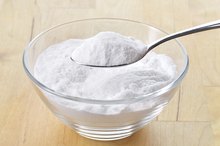Sodium Caseinate Side Effects
Casein and whey are two types of protein naturally found in milk. Both proteins are extracted and used in large quantities to make protein powders and supplements. Sodium caseinate also contains extracted casein protein, but it’s used as a food additive. If you’re allergic to milk, you'll need to avoid sodium caseinate. Other than the risk posed to people with milk allergies, sodium caseinate isn't associated with side effects.
Sodium Caseinate Overview
About 82 percent of the proteins in milk belong to the casein family. Casein proteins are stable when exposed to heat. As a result, they survive pasteurization and they can be dried and reconstituted while retaining their nutritional value, reports Cornell University’s Milk Facts.
Sodium caseinate is made by mixing extracted casein with a sodium compound such as sodium hydroxide. Then the mix is dried to produce sodium caseinate powder. Sodium caseinate retains the original protein, but other qualities change. One important difference is that milk casein doesn't easily dissolve in fluids, while sodium caseinate is soluble.
- About 82 percent of the proteins in milk belong to the casein family.
- One important difference is that milk casein doesn't easily dissolve in fluids, while sodium caseinate is soluble.
Milk Allergy or Lactose Intolerance
Scandishake Nutrition Information
Learn More
Since sodium caseinate contains milk protein, it can cause an allergic reaction and should be avoided if you're allergic to milk. Also watch for other forms of caseinates and extracted casein, such as calcium caseinate and hydrolyzed casein, recommends Food Allergy Research and Education.
Check the list of ingredients for sodium caseinate. Any type of caseinate in the ingredients should include a note that it comes from milk. Be aware that products labeled dairy-free and nondairy often contain sodium caseinate.
Sodium caseinate is low in lactose, according to a report in Food Science and Nutrition in November 2014. But if you’re highly sensitive to lactose, be careful about consuming products with sodium caseinate, recommends the U.S. Food and Drug Administration.
- Since sodium caseinate contains milk protein, it can cause an allergic reaction and should be avoided if you're allergic to milk.
- Also watch for other forms of caseinates and extracted casein, such as calcium caseinate and hydrolyzed casein, recommends Food Allergy Research and Education.
Side Effects and Quantity
Side effects from consuming sodium caseinate have not been reported to the FDA’s adverse event reporting program; the agency recognizes sodium caseinate as a safe food additive as long as it’s used according to good manufacturing practices. These guidelines state that it must be added to products in the smallest amount required to achieve the desired nutritional or physical value. In other words, sodium caseinate is not intended to be consumed in large quantities. Potential risks from taking a large amount have not been studied.
- Side effects from consuming sodium caseinate have not been reported to the FDA’s adverse event reporting program; the agency recognizes sodium caseinate as a safe food additive as long as it’s used according to good manufacturing practices.
- In other words, sodium caseinate is not intended to be consumed in large quantities.
Sources of Sodium Caseinate
Textured Vegetable Protein and Gluten
Learn More
Manufacturers often use sodium caseinate to boost protein content, but it also fills nonnutritive roles. For example, it adds texture, thickens foods such as sauces and blends with fats so they don’t separate from liquids.
Sodium caseinate is easy to identify in some products because they’re dairy-related. For example, if you check the ingredients, you’ll find it in some brands of ice cream, cheese products, yogurt and coffee creamers.
Look for sodium caseinate in nutritional food bars and sports drinks. A variety of baked goods and other products that you may not suspect also contain sodium caseinate, such as meat products, pasta and soups.
- Manufacturers often use sodium caseinate to boost protein content, but it also fills nonnutritive roles.
- A variety of baked goods and other products that you may not suspect also contain sodium caseinate, such as meat products, pasta and soups.
Related Articles
References
- Cornell University: Milk Facts: Milk Protein
- U.S. Food and Drug Administration: Substances Generally Recognized as Safe
- Food Science and Nutrition: Anti-Inflammatory Effects of a Casein Hydrolysate and its Peptide-Enriched Fractions on TNF Alpha-Challenged Caco-2 Cells and LPS-Challenged Porcine Colonic Explants
- U.S. Food and Drug Administration: MedWatch: The FDA Safety Information and Adverse Event Reporting Program
Writer Bio
Sandi Busch received a Bachelor of Arts in psychology, then pursued training in nursing and nutrition. She taught families to plan and prepare special diets, worked as a therapeutic support specialist, and now writes about her favorite topics – nutrition, food, families and parenting – for hospitals and trade magazines.









